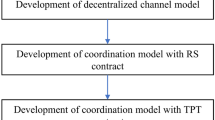Abstract
In order to improve the customer service effect of e-commerce customer service robots, this paper combines the compensation strategy of dual-channel supply chain coordination of e-commerce with the big data perspective to complete the function and system analysis of e-commerce customer service robots. In the study of the dual-channel supply chain, this paper considers the difference between online channels and traditional channel service experience, and uses the dual-channel service competition model to improve the performance of customer service robots. Aiming at the characteristics of online channel service experience and service model, this paper analyzes the model of a single online channel and the dual-channel supply chain model composed of online direct sales channels and traditional single retailer channels. In addition, this paper constructs the customer service robot system structure and uses experiments to verify its performance. The research results show that the algorithm system proposed in this paper is reliable.








Similar content being viewed by others
References
Afan HA, El-shafie A, Mohtar WHMW et al (2016) Past, present and prospect of an Artificial Intelligence (AI) based model for sediment transport prediction. J Hydrol 541(3):902–913
Al-Musawi AA, Alwanas AAH, Salih SQ et al (2020) Shear strength of SFRCB without stirrups simulation: implementation of hybrid artificial intelligence model. Eng Comput 36(1):1–11
Bui DT, Pradhan B, Nampak H et al (2016) Hybrid artificial intelligence approach based on neural fuzzy inference model and metaheuristic optimization for flood susceptibilitgy modeling in a high-frequency tropical cyclone area using GIS. J Hydrol 540(4):317–330
Bui DT, Bui QT, Nguyen QP et al (2017) A hybrid artificial intelligence approach using GIS-based neural-fuzzy inference system and particle swarm optimization for forest fire susceptibility modeling at a tropical area. Agric Meteorol 233(1):32–44
Bui XN, Nguyen H, Choi Y et al (2020) prediction of slope failure in open-pit mines using a novel hybrid artificial intelligence model based on decision tree and evolution algorithm. Sci Rep 10(1):1–17
Chapi K, Singh VP, Shirzadi A et al (2017) A novel hybrid artificial intelligence approach for flood susceptibility assessment. Environ Model Softw 95(1):229–245
Chou JS, Bui DK (2014) Modeling heating and cooling loads by artificial intelligence for energy-efficient building design. Energy Build 82(6):437–446
Enshaei A, Robson CN, Edmondson RJ (2015) Artificial intelligence systems as prognostic and predictive tools in ovarian cancer. Ann Surg Oncol 22(12):3970–3975
Fathian F, Mehdizadeh S, Sales AK et al (2019) Hybrid models to improve the monthly river flow prediction: integrating artificial intelligence and non-linear time series models. J Hydrol 575(3):1200–1213
Ferrari R, Mancini-Terracciano C, Voena C et al (2019) MR-based artificial intelligence model to assess response to therapy in locally advanced rectal cancer. Eur J Radiol 118(4):1–9
Ghahramani Z (2015) Probabilistic machine learning and artificial intelligence. Nature 521(7553):452–459
Hashemi MR, Spaulding ML, Shaw A et al (2016) An efficient artificial intelligence model for prediction of tropical storm surge. Nat Hazards 82(1):471–491
Keel S, Lee PY, Scheetz J et al (2018) Feasibility and patient acceptability of a novel artificial intelligence-based screening model for diabetic retinopathy at endocrinology outpatient services: a pilot study. Sci Rep 8(1):1–6
Laird JE, Lebiere C, Rosenbloom PS (2017) A standard model of the mind: toward a common computational framework across artificial intelligence, cognitive science, neuroscience, and robotics. AI Mag 38(4):13–26
Lu H, Li Y, Chen M et al (2018) Brain intelligence: go beyond artificial intelligence. Mob Netw Appl 23(2):368–375
Nourani V, Baghanam AH, Adamowski J et al (2014) Applications of hybrid wavelet–artificial intelligence models in hydrology: a review. J Hydrol 514(9):358–377
Pham BT, Nguyen MD, Van Dao D et al (2019) Development of artificial intelligence models for the prediction of Compression Coefficient of soil: an application of Monte Carlo sensitivity analysis. Sci Total Environ 679(8):172–184
Sun X, Young J, Liu JH et al (2018) Prediction of pork loin quality using online computer vision system and artificial intelligence model. Meat Sci 140(7):72–77
Sustrova T (2016) A suitable artificial intelligence model for inventory level optimization. Trends Econ Manag 10(25):48–55
Yaseen ZM, El-Shafie A, Jaafar O et al (2015) Artificial intelligence based models for stream-flow forecasting: 2000–2015. J Hydrol 530(7):829–844
Zappone A, Di Renzo M, Debbah M et al (2019) Model-aided wireless artificial intelligence: Embedding expert knowledge in deep neural networks for wireless system optimization. IEEE Veh Technol Mag 14(3):60–69
Funding
There was no outside funding or grants received that assisted in this study.
Author information
Authors and Affiliations
Corresponding author
Ethics declarations
Conflict of interest
The authors declared that they have no conflicts of interest to this work. We declare that we do not have any commercial or associative interest that represents a conflict of interest in connection with the work submitted.
Additional information
Publisher's Note
Springer Nature remains neutral with regard to jurisdictional claims in published maps and institutional affiliations.
Rights and permissions
About this article
Cite this article
Zhang, C., Ren, M. Customer service robot model based on e-commerce dual-channel channel supply coordination and compensation strategy in the perspective of big data. Int J Syst Assur Eng Manag 14, 591–601 (2023). https://doi.org/10.1007/s13198-021-01325-2
Received:
Revised:
Accepted:
Published:
Issue Date:
DOI: https://doi.org/10.1007/s13198-021-01325-2




